
However bad economic conditions were for Poles in the two decades between the world wars, economic conditions for the Jews of Poland were even worse. The first census taken in independent Poland in 1921 revealed that there were slightly less than 2,800,000 Jews in the country. As a result of widespread anti-Semitism, Jews were generally not hired to work in factories, businesses, or offices owned by Poles, nor by Polish municipalities. In addition, a number of large Jewish-owned firms and factories also declined to hire Jews—either to avoid potential tension between non-Jewish and Jewish employees, or to avoid conspicuously different holidays and Sabbaths for two groups of workers. Because it was so hard for Jews to find work in interwar Poland, it was difficult to organize Jewish workers.
From the beginning, the deep political differences among Polish Jewish political parties exacerbated the problems involved in creating or sustaining Jewish trade unions. After the establishment of independent Poland, several different Jewish political parties vied for influence among Jewish workers, and each created or fostered trade unions affiliated with their party. In the period immediately after the end of the First World War, a little more than six thousand Jewish workers in all of Poland were enrolled in unions that were led by the Po‘alei Ziyon. A little fewer than six thousand were members of unions led by the Fareynikte (the United Jewish Socialist Workers’ Party). Bundist-led unions had more than twenty thousand members at that time in Warsaw alone.
Bundist unions remained the largest and most important Jewish unions in Poland throughout the interwar era. The unions associated with the Bundist-dominated National Council of Professional Class Unions in Poland (Land-rat fun di profesionele klasn-fareynen in poyln), or its successors, showed impressive growth. However, the course of the Land-rat was neither smooth nor steady. The membership of its affiliates dipped significantly at various points in the 1920s and 1930s, as a result of disputes fanned by Jewish communists, as well as other factors. Nevertheless, in the years immediately preceding the Second World War, the Land-rat dramatically increased its strength. The Land-rat represented just fewer than 72,000 members in 1937. It had more than 99,000 members in its constituent unions in 1939. The Land-rat was, therefore, many multiples larger than the Bund itself on the eve of the Second World War, and served, at that moment in time, as a major reservoir of Bundist strength in local elections and in other matters.
Information has long been available on the Land-rat’s leading figures, including well-known Bundists such as Victor Alter, Sara Shveber, and Shmuel (Artur) Zygielbaum. Until recently, it has been difficult to get a sense of the nature of the rank-and-file members of Polish Jewish trade unions. Documents unearthed in Lithuania now make it possible to provide a snapshot of the members of one such union—the Union of Trade Employees (Profesionele fareyn fun handls-ongeshtelte)—in an exceptionally important location, the city of Vilna. Under the leadership of Yankl Zhelezhnikov, a prominent and active Bundist, the union in the interwar period was comprised of individuals who were employees in stores and businesses (as distinguished from factory workers or artisans employed in workshops). Although there is no reason to think that this union was necessarily representative of unions in which Jews dominated, a closer look at this union is nevertheless revealing.
On November 1, 1922, Vilna’s Union of Trade Employees had 1,127 members. A detailed description of the union’s membership dated January 20, 1924 reveals that its membership had fallen sharply and rapidly in the period of a year. In 1924, the union had only 775 members. Of the regular members, 597 were Jews. Forty-five of the regular members were not. In addition to these 642 individuals, the union had 133 members in its “youth section,” which was made up of workers who were under 18 years of age (some of whom were as young as 12) and about whom neither ethnic nor religious affiliations are provided. The union was divided into twenty branches, each of which consisted of employees working in businesses in a specific trade. The single largest branch, which had, in 1924, 106 members (including “youth” members) was the “manufaktur” (textiles) branch. The second largest, which had 86 members, was the “kolonial” branch, made up of those who worked in entities which sold items like coffee, tea, and spices, items imported from “colonies.” The branches which were made up of those who worked for the community—the kehile—and by those employed by haberdasheries also had significant numbers of members. The smallest branches were made up of those consisting of employees in businesses devoted to wood (4 members), wine (11), shipping (14), hats and furs (18), and furniture and glass (18). Several branches—including those in the haberdashery trade and those in the shoe trade—had more female members than males. Most of the men in this union were married. On the other hand: most of the women were not (because, I suspect, women who married tended to work at home rather than continuing to hold paying jobs outside the home). There were more workers in the union aged 21 to 30 than in any other age group. Twenty-two of the workers—twenty-one males and one female—were between 51 and 60. Only fourteen—all male—were above 61.
Why was it that Vilna’s Union of Trade Employees saw such a precipitous drop in its membership between the end of 1922 and the beginning of 1924? 1923 was a year characterized by hyperinflation, which sharply reduced the value of the typical wage. The drop in living standards led to a general strike, which was followed by severe economic need, widespread hunger, and hundreds of arrests. The large increase in the number of unemployed workers might account for the many instances in which workers, unable to support themselves or their families, committed suicide. In all likelihood, there were fewer Jews employed in stores and businesses in Vilna at the end of 1923 than there had been at the beginning of that year. This, in itself, would explain the drop in the union’s membership. It is possible that other factors could also explain this phenomenon. Some Jewish trade employees, either deeply disappointed by the results of the strike tactics or no longer able to afford membership dues, may have voted with their feet by dropping out of the union.
Power, Foucault has taught us, is often best understood not by looking from the top down, not by, for example, focusing (merely) on the bourgeoisie’s domination of capitalist society, but rather by looking from the bottom up. Jewish labor in eastern Europe—the “pariah among pariahs” as Kautsky once described it—was very much at the bottom. The history of Jewish labor should not be presented, as some early studies may suggest, as a history primarily of leaders or institutions or parties, but a history of the lives, actions and reactions of rank and filers. By using a microhistorical approach, a Foucauldian analysis of power from the bottom up, and newly available sources, we might well learn a great deal about Jewish labor in interwar Poland—and may be able to shed additional light, more generally, on the power dynamics of Jewish life in that critically important albeit very troubled land.


